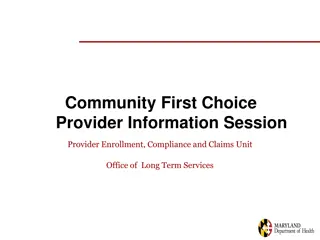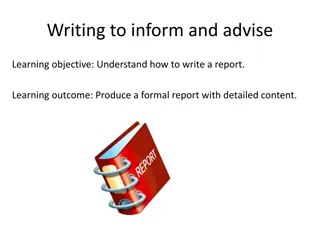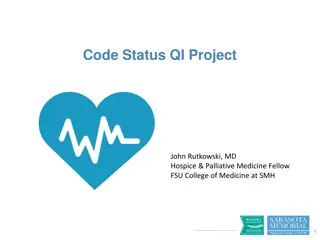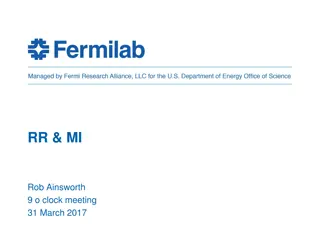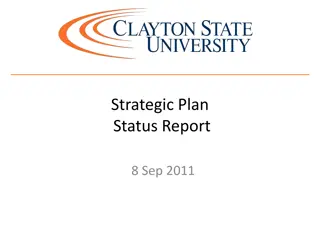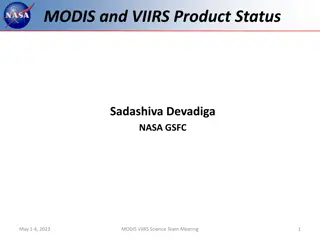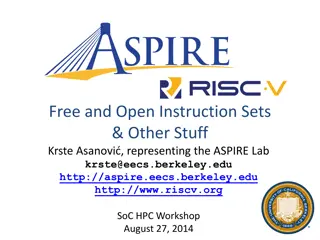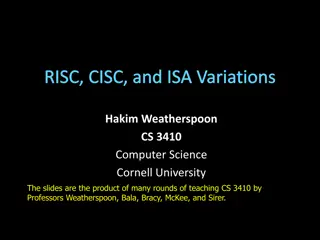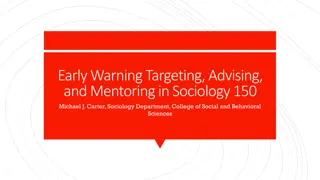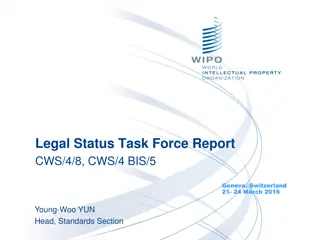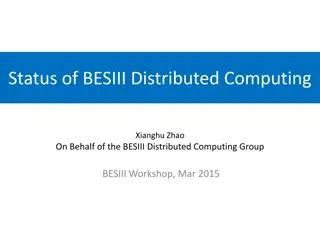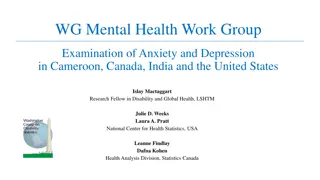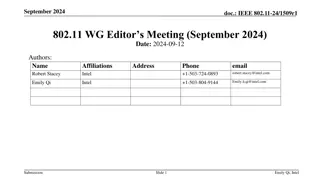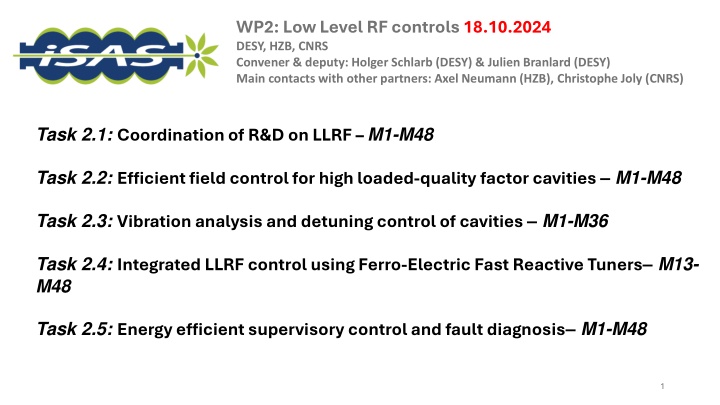
Advanced Low-Level RF Controls and Development Progress
Explore the evolution of tasks in the Low-Level RF (LLRF) control domain, including coordination of research and development, efficient field control for high loaded-quality factor cavities, vibration analysis, and detuning control. Learn about the status updates, activities, and future milestones in LLRF projects involving partners like DESY, HZB, and CNRS.
Download Presentation

Please find below an Image/Link to download the presentation.
The content on the website is provided AS IS for your information and personal use only. It may not be sold, licensed, or shared on other websites without obtaining consent from the author. If you encounter any issues during the download, it is possible that the publisher has removed the file from their server.
You are allowed to download the files provided on this website for personal or commercial use, subject to the condition that they are used lawfully. All files are the property of their respective owners.
The content on the website is provided AS IS for your information and personal use only. It may not be sold, licensed, or shared on other websites without obtaining consent from the author.
E N D
Presentation Transcript
WP2: Low Level RF controls 18.10.2024 DESY, HZB, CNRS Convener & deputy: Holger Schlarb (DESY) & Julien Branlard (DESY) Main contacts with other partners: Axel Neumann (HZB), Christophe Joly (CNRS) Task 2.1: Coordination of R&D on LLRF M1-M48 Task 2.2: Efficient field control for high loaded-quality factor cavities M1-M48 Task 2.3: Vibration analysis and detuning control of cavities M1-M36 Task 2.4: Integrated LLRF control using Ferro-Electric Fast Reactive Tuners M13- M48 Task 2.5: Energy efficient supervisory control and fault diagnosis M1-M48 1
WP2 LLRF: status/evolution of Task 2.1 Task 2.1: Coordination of R&D on LLRF M1-M48 A couple of meetings took place since last status update Status update of the different labs Reporting about iSAS project activities (website, next in-person meeting) Communication structure established Email distribution list Shared repository (meeting minutes, status reports, presentations) Identified test possibilities in each lab Test stands, facilities, type of cavities, tuning systems, power sources, etc. 2
WP2 LLRF: status/evolution of Task 2.2 Task 2.2: Efficient field control for high loaded-quality factor cavities M1-M48 Identify optimal loaded-quality factor (QL) to achieve efficient field control for various operation scenarios. Investigated impact of choice of QL on efficiency through simulation Challenges for long pulsed and CW are different (in particular efficient filling) Evaluate methods for changing QL (at the cavity coupler and waveguide level). Tests done at HoBiCat (HZB) with 3-stub tuner Modify test stand (DESY) for operation with SSA : done and approved by TUEV Currently preparing for tests with high QL (end of 2024, beginning of 2025) 2x 8kW SSA purchased for further tests at AMTF Investigate benefits of advanced ML-based combined RF and mechanical feedback controllers. Started investigation to model transfer function PZT RF (ongoing) New position awarded at HZB + PhD at DESY. Demonstrate RF-efficient control in continuous wave (CW) and long pulse (LP) operation. i.e. Final demonstrator (milestone) expected towards the end of iSAS timeframe 3
WP2 LLRF: status/evolution of Task 2.3 Task 2.3: Vibration analysis and detuning control of cavities M1-M36 Characterize environmental disturbances and transfer to the cavity perturbation. Test using ext. geophones at CMTB (PhD thesis Uni. Lodz, thesis submitted) First tests with beam at SeaLab (BerLinPro) planned for October 24 (microphonics evaluation) Investigate and develop detuning counter measures based on advanced feedforward, feedback and active noise cancellation including AI methods. Successfully demonstrated Luenberger Observer to estimate bandwidth and detuning Demonstrated in pulsed and CW Module implemented in firmware, (currently verification phase), test in the field beg. of 2025 4
WP2 LLRF: status/evolution of Task 2.4 Task 2.4: Integrated LLRF control using Ferro-Electric Fast Reactive Tuners M13-M48 Integrate a ferro-electric fast reactive tuner (FE-FRT) with a digital LLRF system Hardware development 2026/27 within WP1 Simulation on effect and operation range can be carried out When type and actuation is defined, digital interface can be defined no new results since report in July Demonstrate microphonics compensation using a FE-FRT at a horizontal test stand Depends on WP1 outcome Development of Matlab/Simulink model of RF control loop to simulate resonance control for PERL (ICJLab) ongoing FE-FRT can be included in model 5
WP2 LLRF: status/evolution of Task 2.5 Task 2.5: Energy efficient supervisory control and fault diagnosis M1-M48 Develop schemes to adjust solid state amplifier (SSA) parameters for efficient RF generation. Contacted Cryoelectra GmbH to assess feasibility and interest IB meeting during German holiday (neither Holger nor myself can attend) Investigate RF control parameters for energy-efficiency optimization using ML methods Developed improved algorithm for more efficient Lorentz force detuning compensation Double sine (instead of single) and smooth start to limit AC power and current on piezo Tested and deployed at XFEL Develop fault diagnosis and anomaly detection of LLRF systems using ML approaches 1st milestone delivered and approved : (D35) ML implementation plan Demonstration of quench detection in CW using Luenberger Observer Implementation of real-time fault detection on FPGA, firmware done, test phase Implementation of a real-time fault detection on server, deployed in 1 RF station at XFEL (observation phase) 6
WP2 LLRF: points of attention Personnel setback key person for R&D left DESY in Fall 2024 mitigation: opened replacement position but challenging to find qualified personnel Dependence of iSAS R&D on laboratory schedule availability of test stands is not always predictable (delay, warm up, etc..) mitigation: compiled a list of tests capabilities in partner labs Future hardware development on going Evolution step : Development of next generation digitizers (heterodyne detection mode) Revolution step : First successful test of CSI (carrier suppression interferometer) integration with LLRF system at test stand with cavity 7
WP2 LLRF: plans to achieve milestones & deliverables Deliverables and Milestones are still fine and in reach To support the WP2 program additional position will be open: 1) at DESY ~Q4/24 2) HZB done 8 Currently reviewing candidates
WP2 LLRF: budget plans No deviations 9




